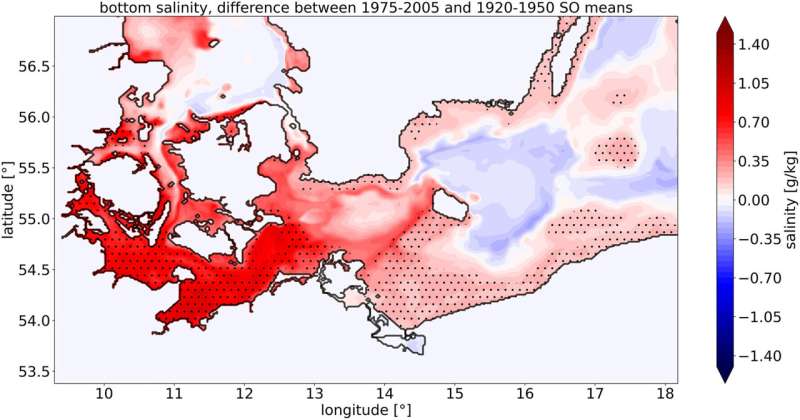This article has been reviewed according to Science X's editorial process and policies. Editors have highlighted the following attributes while ensuring the content's credibility:
fact-checked
peer-reviewed publication
proofread
Model simulations find the cause of unusually high temperatures at the bottom of the Bornholm Sea

The water temperature at the bottom of the Bornholm Basin in the central Baltic Sea has risen faster in recent decades than at the surface. Warnemünde researchers have now been able to explain this unusual development with a temporal shift in the exchange of water between the North Sea and the Baltic Sea. This leads—in addition to the rapid temperature increase in the surface water, which can be observed everywhere in the Baltic Sea and is due to global warming—to a temperature increase in the deep water, too. The research results have now been published in the journal Geophysical Research Letters.
Worldwide, we are registering an increase in the surface temperatures of the oceans due to global warming—including in the Baltic Sea. While the surface water reacts relatively quickly to the higher temperature of the atmosphere, the deeper water absorbs the heat with a delay. In some areas of the Baltic Sea; however, the deeper layers are warming faster than the surface water. How can this be? Leonie Barghorn, a physical oceanographer at the Leibniz Institute for Baltic Sea Research, and her colleagues investigated whether temporal changes in the inflow of North Sea water into the Baltic Sea could be the cause.
The brackish water Baltic Sea draws its salt content from the North Sea. However, the inflowing North Sea water is heavier than the brackish water of the Baltic Sea due to its higher salinity and therefore flows in at the bottom of the Baltic Sea. This is not a permanent process, because the Baltic Sea usually has a high filling level due to numerous rivers and large annual precipitation amounts, resulting in a strong outflow. Only under certain meteorological and / or oceanographic conditions do these conditions reverse, allowing North Sea water to enter the Baltic Sea.
For decades, autumn and winter storms were considered the main drivers of these conditions. In 2002, a saltwater inflow could be for the first time identified and studied in more detail that deviated from this pattern: during calm summer weather, an inflow of North Sea water into the Baltic Sea was driven by horizontal salinity differences alone. While these events are much weaker in scale, they do occur more frequently. And, of course, North Sea water flowing into the Baltic Sea in summer or early autumn is significantly warmer than that entering via winter inflows.
There are still no sufficiently long observation series on the summer inflows, so a trend analysis based on the measured data is fraught with too much uncertainty. Barghorn has therefore used model simulation to investigate whether within the last 150 years the frequency of saltwater inflows in summer and early autumn has increased and whether there is a causal link to the temperature increase in the deep waters of the Bornholm Sea.
"We analyzed a so-called hindcast simulation covering the period from 1850 to 2008," Barghorn explains. "By comparing the data from the two seasons, summer and early autumn, with those for the year as a whole, it was possible to clearly see that the summer and early autumn salt input increased and the winter input decreased during the model period considered."
While the Arkona Basin, which is upstream of the Bornholm Basin, is regularly mixed due to its shallower depth, so that the inflowing warm saltwater is distributed over the entire water column, the downstream Gotland Basin is not accessible to the small summer to early autumn saltwater inflows. Thus, only the Bornholm Basin has conditions that make this "bottom heating" visible.
Co-author Markus Meier adds, "We don't yet know exactly what caused the shift in salinity input to the warm season. For the Bornholm Basin, at any rate, the consequences can be serious, because higher temperatures will also drive oxygen depletion and thus promote the spread of 'dead zones.'"
More information: L. Barghorn et al, Changes in Seasonality of Saltwater Inflows Caused Exceptional Warming Trends in the Western Baltic Sea, Geophysical Research Letters (2023). DOI: 10.1029/2023GL103853
Journal information: Geophysical Research Letters
Provided by Leibniz-Institut für Ostseeforschung Warnemünde



















